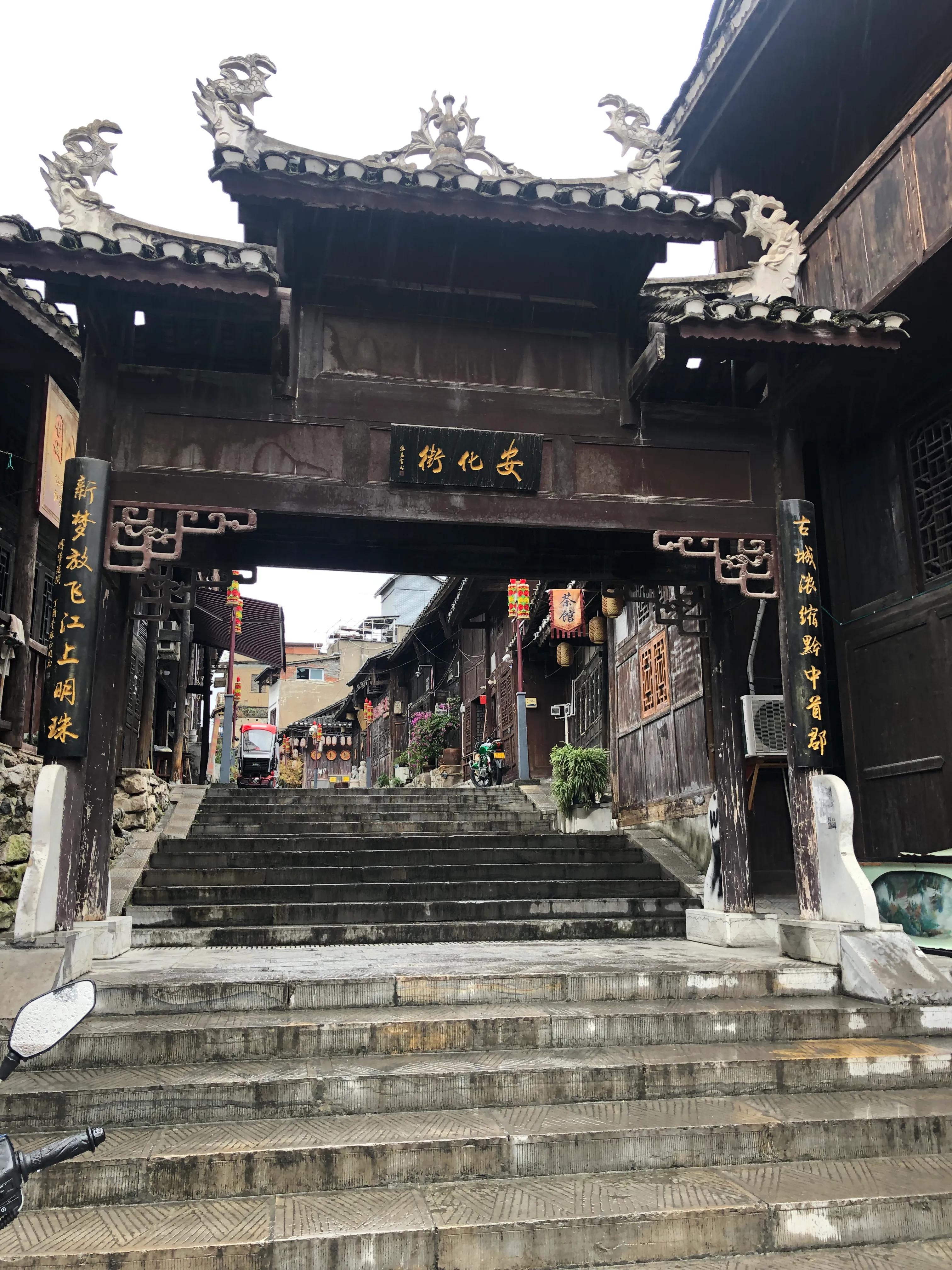Guizhou Sinan Ancient City has a history of more than 1800 years, since ancient times has the reputation of "Qianzhong Shoujun Wujiang Pearl", to this day, this water mountain city that has gone through the vicissitudes of time, there are still many cultural relics and ancient rhymes. Guizhou's 5A scenic spots are not many, Sinan County Sitang Ancient Building Complex is one of them, self-driving through here, it is indispensable to walk around.
On the fame of tourist attractions, Fanjing Mountain, which is not far from here, can be described as famous, but Fanjing Mountain we came to visit in May last year, so we came to Sitang Gujian group today for a visit.
Gaode navigation led us to the Wujiang Museum, which is the ancient building group of laoye temples. Most of the Sitang Ancient Construction Group is on the Wu River in Sinan County.
Wujiang, ancient known as Yanjiang, also known as Qianjiang, Fushui, originated in Weining County, the eastern foothills of Wumeng Mountain, Wujiang has a total length of 1050 kilometers, it is the mother river of Guizhou, flowing along the river through Qianxi, Jinsha, Xifeng, Zunyi, to the Wujiang River after crossing the Wujiang River, through Kaiyang, Meitan, Fenggang, Shiquan, Sinan, Dejiang, Yanhe and other counties, turn northwest into Chongqing city, through Youyang, Pengshui, Wulong to Fuling to join the Yangtze River.
The main ethnic minorities along the Wujiang River basin are Yi, Miao, Hui, Buyi, Bai, Lao, Tujia, etc. The upstream beach is dangerous and rapid, and cannot be navigated; the middle reaches can be navigated in sections; the downstream 100-ton freighter can smooth Sinan, and in ancient times, the Wujiang River became an important water transport channel for civil boat trade and military water transportation under Shu Chu and yunnan and Guizhou.
Ancient Sichuan Qianxiangdian traffic to Wujiang shipping, water and land, from the Yujing Fuling wharf to transfer the Yangtze River unloaded Sichuan salt, trace the Wujiang River through Fuling, Wulong, Pengshui, Gongtan, along the river, tide, to Sinan, and then radiate from land to Qiandong, Qiandongnan and other places, historically known as "Sichuan salt into Qian", "Sichuan salt into Qian" to solve the problem of Guizhou people eating salt; ships down the Wu river, the tung oil, skin, medicinal materials, lacquer, cinnabar and other Guizhou native products water out of Qian, sold to all parts of the country, This transportation route is the famous "Wujiang Salt Oil Ancient Road". It not only drives the economic development of Yuqian, but also brings advanced production technology with the migration of a large number of immigrants. The fusion of various cultures and the interaction of economy made the Wujiang River Basin one of the economically developed and culturally prosperous areas in Yuqian at that time, which greatly promoted the process of cross-strait civilization, and its historical value was comparable to that of the Tea Horse Ancient Road between Yunnan and Tibet.
As a transit station on the "Salt Oil Ancient Road", the development and prosperity of Sinan are inseparable from the Wujiang River, and without the unique golden waterway of the Wujiang River, there will be no rapid development of the economic culture of ancient Sinan.
Zhang Minwen, a poet of the Tujia family in the Qing Dynasty, said: "In those days, the fire knife cultivated the land, and the flowers on this day were full of flowers. Sand mercury factory connected to gold and iron works, small salt boats to large salt ships. "Now the hustle and bustle is gone, the deep Water of the Wujiang River seems to be remembering the prosperity of the past, wandering on the bank of the Wujiang River, looking at the steep cliffs on both sides of the Wujiang River, on the cliffs there are also the fibers of the old haulers pulling boats to walk, looking at the fibers, the backs of the sweaty haulers seem to appear in front of their eyes again, they climb the wall with difficulty, and the Qingyue boatman trumpets shouted out of their mouths, through the canyon, drifted into the distance...
The well-preserved Anhua Ancient Street has traveled through time and space, and the pieces of connected ancient buildings seem to be still telling the history and culture of the Yanhao, the Fuwen Temple, the Zhouheshun Salt Temple, the Wanshou Palace, the Former Residence of the Martyr Kuang Jixun, the Wangye Temple, the Yongxiang Temple, the Chuan main palace...
Cultural relics and monuments are the carrier of history and culture, it interprets a specific regional culture with its own unique charm, it is a treasure bred on this side of the water and soil, and it is also a reproduction of the image of Sinan civilization.
It took the whole morning, and my brain was filled with antiquity and vicissitudes. Hungry, a large bowl of affordable intestinal noodles is full of strong aroma, and it is a great pleasure to eat.
In the afternoon, go to the next stop at the Border City Tea Pass. National highways and provincial roads, as well as dozens of kilometers of rural roads, the sky is overcast, the thick fog condenses into water vapor, and the drizzle generally pours into the car glass, entering Guizhou for a week, and this is the weather every day. Although it is slower not to take the high speed, driving is like walking in a painting of ink and danqing, and the eyes are not ready to give beauty. "Walk slowly and appreciate it."
From Songtao out of Guizhou, into Chongqing Xiushui, tomorrow morning, to Hong'an in Xiushui County, the bridge is the tea in Huayuan, Hunan, Shen Congwen's "Border City", which is the place where the three provinces meet.
Drive 200 kilometers today and stay overnight in Chongqing Xiushui Yajiang.
